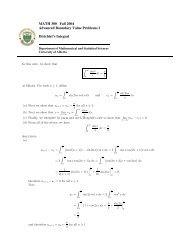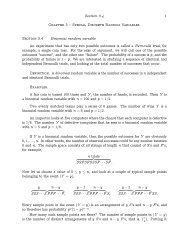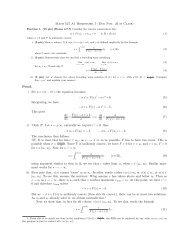Math 411: Honours Complex Variables - University of Alberta
Math 411: Honours Complex Variables - University of Alberta
Math 411: Honours Complex Variables - University of Alberta
You also want an ePaper? Increase the reach of your titles
YUMPU automatically turns print PDFs into web optimized ePapers that Google loves.
12.2. THE GAMMA FUNCTION 83<br />
Since α < 1, we see that the contribution from the circular arc CR is<br />
��<br />
�<br />
� �<br />
�<br />
� f�<br />
�<br />
CR<br />
≤ Rα−1<br />
R<br />
2<br />
·2πR = 4πR α−1 →<br />
R→∞ 0.<br />
Likewise, since α > 0, the contribution from the semicircular contour Cr is<br />
��<br />
�<br />
� �<br />
�<br />
� f�<br />
�<br />
We thus deduce that<br />
Thus<br />
Cr<br />
2πie (α−1)iπ = lim<br />
r→0<br />
≤ rα−1<br />
1<br />
2<br />
R→∞ ir<br />
� ∞<br />
e (α−1)log|z|<br />
·πr = 2πr α →<br />
r→0 0.<br />
�� R+ir � R−ir<br />
f −<br />
=<br />
0 +<br />
dz −<br />
1+z<br />
= I(α) � 1−e (α−1)2πi� .<br />
�<br />
f<br />
−ir<br />
� ∞<br />
e (α−1)(log|z|+i2π)<br />
0 +<br />
1+z<br />
π = I(α)· e−(α−1)πi −e (α−1)πi<br />
= I(α)·<br />
2i<br />
−e−απi +eαπi ,<br />
2i<br />
from which we see that<br />
I(α) = Γ(α)Γ(1−α) = π<br />
sinπα ,<br />
On extending this result by analytic continuation, one finds for all z ∈ C \ Z<br />
that<br />
Γ(z)Γ(1−z) = π<br />
sinπz .<br />
• For α ≥ 1 and positive x and λ, another frequently encountered integral can be<br />
expressed in terms <strong>of</strong> Γ using the substitution u = xtλ :<br />
�<br />
� ∞<br />
0<br />
e −xtλ<br />
t α−1 dt = 1<br />
λx α<br />
λ<br />
0<br />
� ∞<br />
0<br />
e −u u α<br />
λ−1 du = Γ� α<br />
λ<br />
λx α<br />
λ<br />
For the special case α = x = 1, this result simplifies to<br />
� ∞<br />
e −tλ<br />
dt = 1<br />
λ Γ<br />
� � �<br />
1<br />
= Γ 1+<br />
λ<br />
1<br />
�<br />
.<br />
λ<br />
For 0 < α < 1 and x > 0, a related integral is<br />
� ∞<br />
0<br />
e ixt t α−1 dt = iα Γ(α)<br />
x α .<br />
dz<br />
. (12.3)<br />
(12.4)<br />
To establish this result, it is convenient to introduce a branch cut, shown in<br />
red, along the negative real axis:







